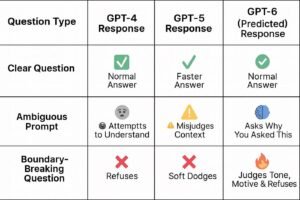There’s growing excitement (and a fair share of speculation) around GPT-6, OpenAI’s next-generation model. Want to know more? Stick around as we explore GPT-6 Rumours: Everything We Know.
Thank you for reading this post, don't forget to subscribe!While nothing has been fully confirmed, several strong rumours are emerging including possible release timing, key features, and infrastructure bets.
Below, we dive into everything we know so far about GPT-6 and what to watch out for.
See also:
Why People Are Talking About GPT-6
GPT-6 isn’t just “the next version” many believe it could be a major leap in AI: not just bigger, but smarter, more personal, and more capable. GPT-6 Rumours: Everything We Know is here to help you prepare. Analysts are especially pointing to:
-
Persistent memory (so it can “remember” you)
-
More agent-like reasoning, meaning it may complete multi-step tasks on its own
-
Voice customisation; tone, emotional inflection, and more natural interaction
-
And a stronger safety/ alignment framework
This isn’t just hype: the speculation is backed by roadmap signals, infrastructure moves, and OpenAI’s own cautious timeline.
What’s the Likely Release Window for GPT-6?



Here’s where things currently stand:
-
No 2025 launch. OpenAI has denied that GPT-6 will ship in 2025.
-
Expected in 2026, possibly 2027. Several analysts project a release in 2026, though some more cautious forecasts stretch into 2027.
-
Infrastructure constraints. According to Fello AI, OpenAI is working on major hardware investments (e.g., new GPUs) that could become ready in the second half of 2026, aligning with a potential GPT-6 rollout.
-
Shorter gap than before. Some sources suggest the jump from GPT-5 to GPT-6 may be faster than the GPT-4 → GPT-5 cadence, because OpenAI is iterating more aggressively.
-
Name twist: Sam Altman recently teased that “GPT-6” might actually be called “GPT-6-7”, adding to the mystique.
Key Features Capabilities That Are Rumoured
Based on insider leaks, analyst commentary, and roadmap signals, here’s what GPT-6 might bring:
Persistent Memory and Personalisation
-
GPT-6 is expected to support long-term memory, allowing it to remember user preferences, prior conversations, and more.
-
This memory could make the model feel more personal building a user profile to tailor responses over time.
Agent-Style Autonomy
-
The model may act more like an “agent”: GPT-6 could handle multi-step tasks for you (e.g., schedule meetings, make reservations, or summarise documents).
-
That could make it far more useful for productivity, planning, and automation.
Voice Customisation and Emotional Nuance
-
Rumours suggest GPT-6 may allow users to customise voice tone, speed, and emotional inflection, leading to more natural voice interaction.
-
This could be particularly meaningful for voice assistants or applications that require a more “human” feel.
Smarter Reasoning and Continuity
-
According to some reports, OpenAI wants GPT-6 to focus less on pure scale and more on useful reasoning, maintaining context over long conversations.
-
Rather than just responding, GPT-6 may better follow up, ask for clarifications, and make suggestions.
Safety and Alignment
-
Given its increased power, GPT-6 is likely to come with stronger safety mechanisms and governance.
-
There is also speculation that users may have more control over memory; for example, choosing what GPT-6 “remembers” or forgets.
Infrastructure: How OpenAI Might Power GPT-6

What if we told you that OpenAI may be a power horse for GPT-6. As of today;November 2025, when it comes to GPT-6 Rumours: Everything We Know, this lead is highly factual. Here’s why:
-
According to Fello AI, OpenAI is reportedly working on a GPU deal with AMD to scale up its compute capacity for next-gen models.
-
These infrastructure investments suggest GPT-6 could demand “serious horsepower” especially if it supports memory, agent tasks, and voice.
-
Building such a model also requires strong safety infrastructure, which might be one reason for a cautious but ambitious timeline.
Why OpenAI Might Be Taking Its Time
Several factors could delay or complicate a GPT-6 launch:
-
Compute Constraints: Scaling advanced models is expensive and technically demanding.
-
Safety and Alignment: With more memory and autonomy comes more risk. OpenAI may be investing heavily in guardrails.
-
Privacy Concerns: Persistent memory means handling personal data; users will likely expect control over what the model retains.
-
Market Pressure and Expectations: If GPT-6 is highly anticipated, OpenAI must deliver features and reliability to meet expectations.
How Credible Are These Rumours?
-
OpenAI’s official denial of a 2025 release (via trusted outlets) strongly suggests that timeline chatter is overoptimistic.
-
Several features (memory, agents) are consistent across multiple independent leaks and analyst reports.
-
That said, it’s important to remember: nothing is confirmed publicly yet — these are still projections and informed speculation.
-
Some sources (like Fello AI) cite “insider” infrastructure deals, but without OpenAI confirmation, take them as plausible, not certain.
Implications: What GPT-6 Could Mean
If many of these rumours are real, GPT-6 could represent a major shift in how we use AI:
-
For users, it could become a more personal assistant not just answering questions, but remembering you, your habits, and helping you over time.
-
For businesses and developers, GPT-6 could enable AI that automates more complex workflows (e.g., planning, summarisation, agentive tasks).
-
From a safety and ethical perspective, persistent memory and autonomy will raise important questions about data usage and control.
-
For the AI landscape, GPT-6 could solidify OpenAI’s lead, or reset the bar depending on how well it balances power, usability, and trust.
What to Watch Next
Here are some signals to monitor if you want to stay on top of GPT-6 development:
-
OpenAI announcements or blog updates; watch for developer previews or safety research
-
Hardware and GPU news; new generative-AI compute deals may signal forthcoming capacity
-
OpenAI job listings; roles in “memory”, “agent AI”, or “long-context LLMs” could indicate what’s coming
-
Safety audits and policy reports; they often precede big model launches
-
Beta programs; developer previews are likely before a public release
Read on:
Final Thoughts: GPT-6 Rumours: Everything We Know
GPT-6 Rumours: Everything We Know paints a picture of an upcoming model that could be significantly more capable, more personal, and more “autonomous” than what we currently use. While OpenAI hasn’t confirmed many of the specifics, the direction; persistent memory, emotional nuance, agent capabilities aligns with long-term visions for AI assistants.
Realistically, 2026 seems the most likely timeframe for some form of GPT-6 preview or deployment, possibly extending into early 2027 for a full public launch. But with high stakes (infrastructure, safety, privacy), OpenAI appears to be building this carefully.
If GPT-6 delivers on these rumours, we may be entering a new era of AI; one where models don’t just answer, but remember, act, and evolve with us.
Stay Updated
For the latest on GPT-6 and other AI developments, check out Naysblog where we break down tech trends for innovators, founders, and future-builders.
And if you’re building with AI or thinking of integrating GPT-6 in your app or workflow, GWC Tech goes beyond GPT-6 Rumours: Everything We Know to help you roadmap, prototype, and scale intelligently.


